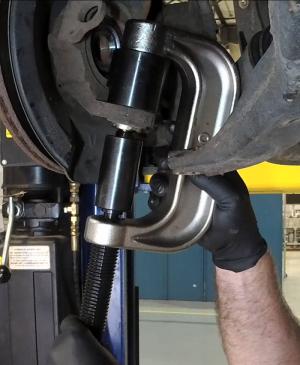The ball joint press tool is the key to a successful installation. This process requires precision and caution to avoid damaging the joint or its surrounding components. By following the correct procedure, you can effectively press the ball joint in place without causing any issues.
We will outline the essential steps for pressing in a ball joint using a ball joint press tool, ensuring a secure and durable installation for your vehicle’s suspension system.

Credit: www.delphiautoparts.com
How To Press Ball Joints Without A Press
To press in a ball joint without a press, you can use a hammer and socket or a hydraulic jack. First, use the hammer and socket method by tapping the joint into the control arm.
If you have a hydraulic jack, place it under the control arm and gently apply pressure to press in the ball joint.
When you’re faced with the task of pressing in ball joints without a proper press, you may wonder how to proceed. Fortunately, there are alternatives to a traditional press that can help you get the job done effectively.
Using A C-clamp And Socket
- Place the ball joint on a stable surface and position the C-clamp over the ball joint with a socket to fit the ball joint stud.
- Tighten the C-clamp until the ball joint is pressed into place. Be sure to apply even pressure to avoid damaging the ball joint.
Hammer And Homemade Tools
- Another method involves using a hammer and homemade tools, such as large sockets or pipes, to press the ball joint in place.
- Use the hammer to tap the homemade tool against the ball joint, gradually applying pressure until the joint is properly seated.
By employing these alternative methods, you can successfully press in ball joints without the need for a press. Whether using a C-clamp and socket or homemade tools, taking the time to apply even pressure and ensure proper placement will result in a secure and reliable installation.
How To Remove A Ball Joint Without A Press
To remove a ball joint without a press, you can use a ball joint removal tool or a hammer and a socket. First, loosen the ball joint nut, then use the tools to separate the joint from the control arm.
Once removed, you can press in the new ball joint using a ball joint press tool.
Removal of a ball joint without a press can be achieved using alternative methods. Typically, a ball joint removal tool, a pickle fork, an angle grinder, or a hammer and a chisel can be utilized to remove the ball joint from the control arm.
These methods can be effective, but caution should be exercised to avoid damaging the surrounding components.
Ball Joint Removal Tool:
- Using a ball joint removal tool involves securing the tool to the ball joint and then using a wrench to apply pressure to extract the joint from the control arm. This method is often recommended for its simplicity and efficiency.
Pickle Fork:
- Alternatively, a pickle fork may be used to separate the ball joint from the control arm. The fork is positioned between the joint and the control arm, and then struck with a hammer to force the joint apart. However, this method can sometimes cause damage to the dust boot or ball joint seal.
Angle Grinder:
- Another method to consider is the use of an angle grinder to cut through the ball joint’s retaining rivets or bolts. This approach requires careful handling to prevent accidental damage to the surrounding components.
Hammer And Chisel:
- Lastly, a hammer and chisel may be utilized to carefully tap around the ball joint’s housing, breaking the joint free from the control arm. This method requires precision and patience to avoid causing harm to the adjoining parts.
Although removing a ball joint without a press is feasible, it is critical to exercise caution and select the method best suited to the specific situation. Prioritize the protection of surrounding components to ensure a successful ball joint removal process.
Conclusion
Pressing in a ball joint is a critical aspect of maintaining your vehicle’s suspension system. By following the proper techniques and using the right tools, you can ensure the ball joint is installed securely and functioning optimally. Paying attention to detail and taking your time with the process will lead to a safe and smooth ride for your vehicle.
